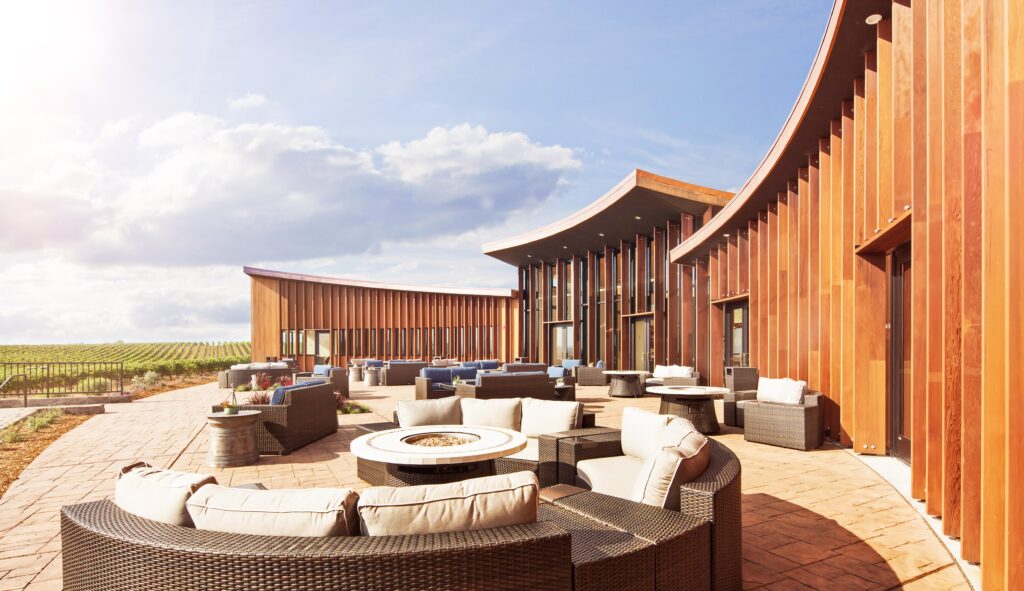
Aging wine in vessels ranging from clay amphorae to concrete eggs is not new – amphorae use can be traced to 6000 BCE. As the industry looks beyond the natural wine trend, more wineries are experimenting with ways to construct a wine’s flavor, crafting small batches of Marsanne and Pinot Gris, Syrah and Semillon. In Napa, the unique flavors of these wines are a fresh selling point, a calling card to attract next gen wine drinkers and grape nerds alike. “We did eight vintages of our pinot gris in stainless steel,” says Bouchaine Vineyards’ President and Winemaker Chris Kajani. “We asked ‘what’s next?’.”
Though some vintners make large enough quantities to sell outside the winery tasting room, most do not. Productions are still small, and most wineries are only able to offer these unique tasting experiences at their tasting rooms or by purchasing a bottle. Sounds like the perfect reason to visit Napa, no? Here’s where to go to taste these up-and-coming, unique wines. (Or, where to go for unique wine tasting experiences in Napa.)
Bouchaine Vineyards Got Me Thinking About Wine Vessels

Tucked into the Carneros region, which includes parts of Sonoma and Napa counties, Bouchaine Vineyards is the vineyard that sent me on a quest to figure out what is up next for winemaking in Napa. From 2022’s harvest, an expansive lineup of wines are now vesseled in clay amphora, concrete eggs and even acacia wood.
Each container adds its own touches and flavors to the finished product. Concrete eggs keep the lees in suspension, adding mouthfeel and texture to pinot gris and chardonnay. Acacia wood is known for a lighter touch than French oak so Kajani is trialing sauvignon blanc in acacia puncheons; Early flavor indicators point to a pop of acidity on the front palate. Into separate, clay amphora sourced from France, Kajani added gewürztraminer and estate-grown syrah. The amphora, she told me, offer more oxygen availability which, in the syrah, translates to a more open wine, one with balanced tannins. In the gewürz, it helps add a gravely backbone to support the grape’s notorious floral notes. 1075 Buchli Station Road, Napa
Napa Winemakers Play With Flavor
Though winemaker Sam Kaplan at Arkenstone is perhaps better known for creating intensely flavorful cabernet sauvignon and syrah, his sauvignon blanc and semillon blend spends 11 months sur-lie aging and moving between a concrete egg, new French oak and aged French oak. The result is a highly sought-after, allocated wine with a robust mid-palate, floral aromatics and natural minerality that may change your mind about the grace of sauvignon blanc. 335 West Lane, Angwin
Kaplan also makes vine in tiny amounts for Vangone Estate just east of Oakville, including a unique Marsanne fermented in wooden puncheons, a cask that holds 80 gallons (304 liters) was released in 2020. For the 2023 vintage, Kaplan experimented with amphora, a traditional clay vessel, for the Marsanne. Though there is no tasting room, you can inquire about how to get your hands on some.
Concrete has been used in winemaking since the 19th century. What’s changed is the shape. But tradition still applies at St. Helena’s Markham Vineyards, where winemaker Kimberlee Nicholls uses a concrete “cannonball” to produce the winery’s Frenchman’s Blend, adding a distinctive minerality to the finished wine.

Over in Napa’s Stag’s Leap District, Cliff Lede Vineyards, too, is playing with blends, fermenting sauvignon blanc, sauvignon vert and semillon separately in oak, stainless steel and concrete eggs to increase the resulting wine’s complexity, then blending the variables together, adding dimensionality and texture.
And in Calistoga, winemaker Peter Velleno at Castello di Amorosa hastried several varieties – chardonnay, pinot bianco, and gewürztraminer – in concrete over the years. “We have settled on one wine to make,” Velleno said, “100% pinot noir rosé, which we bottle as Cresta d’Oro Vineyard Rosato, because it has been our most successful.” He now dedicates all of the vineyard’s egg tanks to it.
The Trend is Not Just Napa
The phenomenon is not limited to Napa. Over in Sonoma’s Dry Creek Valley, winemaker Nick Briggs at Dutcher Crossing Winery used 300 liter cigar barrels (larger than a barrique, smaller than a puncheon) to make the winery’s 2023 CFM sauvignon blanc and has been experimenting with 400L Ovonums for sauvignon blanc and chardonnay, utilizing the cylindrical egg shape to improve flavorful exchanges between juice and wood.

